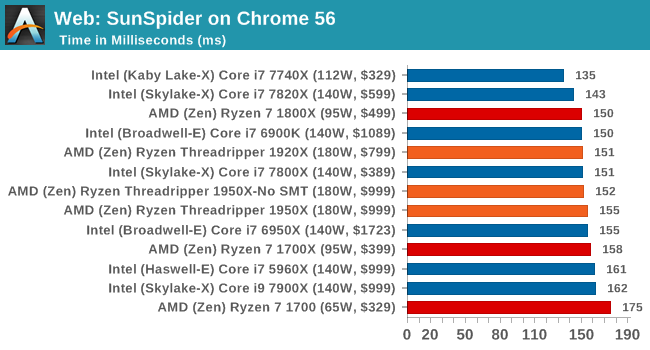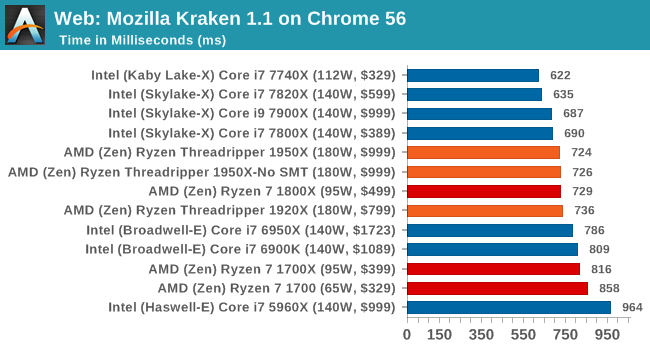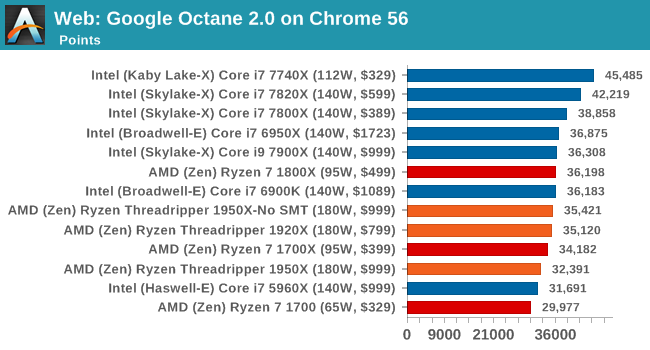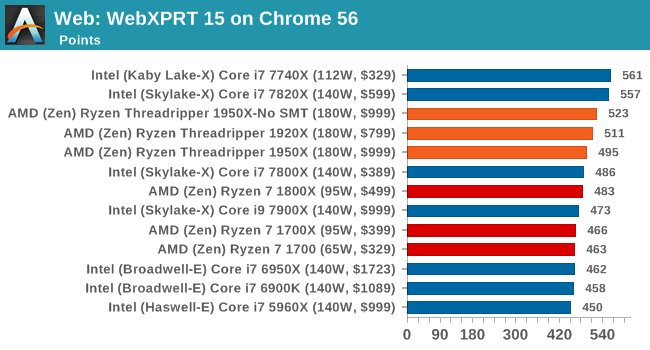The AMD Ryzen Threadripper 1950X and 1920X Review: CPUs on Steroids
by Ian Cutress on August 10, 2017 9:00 AM ESTCPU Web Tests
One of the issues when running web-based tests is the nature of modern browsers to automatically install updates. This means any sustained period of benchmarking will invariably fall foul of the 'it's updated beyond the state of comparison' rule, especially when browsers will update if you give them half a second to think about it. Despite this, we were able to find a series of commands to create an un-updatable version of Chrome 56 for our 2017 test suite. While this means we might not be on the bleeding edge of the latest browser, it makes the scores between CPUs comparable.
All of our benchmark results can also be found in our benchmark engine, Bench.
SunSpider 1.0.2: link
The oldest web-based benchmark in this portion of our test is SunSpider. This is a very basic javascript algorithm tool, and ends up being more a measure of IPC and latency than anything else, with most high-performance CPUs scoring around about the same. The basic test is looped 10 times and the average taken. We run the basic test 4 times.

Mozilla Kraken 1.1: link
Kraken is another Javascript based benchmark, using the same test harness as SunSpider, but focusing on more stringent real-world use cases and libraries, such as audio processing and image filters. Again, the basic test is looped ten times, and we run the basic test four times.

Google Octane 2.0: link
Along with Mozilla, as Google is a major browser developer, having peak JS performance is typically a critical asset when comparing against the other OS developers. In the same way that SunSpider is a very early JS benchmark, and Kraken is a bit newer, Octane aims to be more relevant to real workloads, especially in power constrained devices such as smartphones and tablets.

WebXPRT 2015: link
While the previous three benchmarks do calculations in the background and represent a score, WebXPRT is designed to be a better interpretation of visual workloads that a professional user might have, such as browser based applications, graphing, image editing, sort/analysis, scientific analysis and financial tools.

Overall, all of our web benchmarks show a similar trend. Very few web frameworks offer multi-threading – the browsers themselves are barely multi-threaded at times – so Threadripper's vast thread count is underutilized. What wins the day on the web are a handful of fast cores with high single-threaded performance.










347 Comments
View All Comments
drajitshnew - Thursday, August 10, 2017 - link
You have written that "This socket is identical (but not interchangeable) to the SP3 socket used for EPYC,".Please, clarify.
I was under the impression that if you drop an epyc in a threadripper board, it would disable 4 memory channels & 64 PCIe lanes as those will simply not be wired up.
Deshi! - Friday, August 11, 2017 - link
No AMD have stated that won;t work. Its probably not hardware incompatible, but they probably put microcode on the CPUS so that if it doesn;t detect its a Ryzen CPU it doesn't work. There might also be differences in how the cores are wired up on the fabric since its 2 cores instead of 4. Remember, Threadripper has only 2 Physical Dies that are active. on Epyc all processors are 4 dies with cores on each die disabled right down to the 8 core part. (2 enabled on each physical die)Deshi! - Friday, August 11, 2017 - link
Wish there was an edit function..... but to add to that, If you pop in an Epyc processor, it might go looking for those extra lanes and memory busses that don;t exist on Threadripper boards, hence cause it not to function.pinellaspete - Thursday, August 10, 2017 - link
This is the second article where you've tried to start an acronym called SHED (Super High End Desktop) in referring to AMD Threadripper systems. You also say that Intel systems are HEDT (High End Desktop) when in all reality both AMD and Intel are HEDT. It is just that Intel has been keeping the core count low on consumer systems for so long you think that anything over a 10 core system is unusual.AMD is actually producing a HEDT CPU for $1000 and not inflating the price of a HEDT CPU and bleeding their customers like Intel was doing with the i7-6950X CPU for $1750. HEDT CPUs should cost about $1000 and performance should increase with every generation for the same price, not relentlessly jacking the price as Intel has done.
HEDT should be increasing in performance every generation and you prove yourself to be Intel biased when something finally comes along that beats Intel's butt. Just because it beats Intel you want to put it into a different category so it doesn't look like Intel fares as bad. If we start a new category of computers called SHED what comes next in a few years? SDHED? Super Duper High End Desktop?
Deshi! - Friday, August 11, 2017 - link
theres a good reason for that. Intel is not just inflating the cost because they want to. It literally cost them much more to produce their chips because of the monolithic die aproach vs AMDs Modular aproach. AMDs yeilds are much better than INtels in the higher core counts. Intel will not be able to match AMDs prices and still make significant profit unless they also adopt the same approach.fanofanand - Tuesday, August 15, 2017 - link
"HEDT CPUs should cost about $1000 "That's not how free markets work. Companies will price any given product at their maximum profit. If they can sell 10 @ $2000 or 100 at $1000 and it costs them $500 to produce, they would make $15,000 selling 10 and $50,000 selling 100 of them. Intel isn't filled with idiots, they priced their chips at whatever they thought would bring the maximum profits. The best way for the consumer to protest prices that we believe are higher than the "right" price is to not buy them. The companies will be forced to reduce their prices to find the market equilibrium. Stop complaining about Intel's gouging, vote with your wallet and buy AMD. Or don't, it's up to you.
Stiggy930 - Thursday, August 10, 2017 - link
Honestly, the review is somewhat disappointing. For a pro-sumer product, there is no MySQL/PostgreSQL benchmark. No compilation test under Linux environment. Really?name99 - Friday, August 11, 2017 - link
"In an ideal world, all software would be NUMA-aware, eliminating any concerns over the matter."Why? This is an idiotic statement, like saying that in an ideal world all software would be aware of cache topology. In an actual ideal world, the OS would handle page or task migration between NUMA nodes transparently enough that almost no app would even notice NUMA, and even in an non-ideal world, how much does it actually matter?
Given the way the tech world tends to work ("OMG, by using DRAM that's overclocked by 300MHz you can increase your Cinebench score by .5% !!! This is the most important fact in the history of the universe!!!") my suspicion, until proven otherwise, is that the amount of software for which this actually matters is pretty much negligible and it's not worth worrying about.
cheshirster - Friday, August 11, 2017 - link
Anandtechs power and compiling tests are completely out of other rewiewers results.Still hiding poor Skylake-X gaming results.
Most of the tests are completely out of that 16-core CPU target workloads.
2400 memory used for tests.
Absolutely zero perf/watt and price/perf analisys.
Intel bias is over the roof here.
Looks like I'm done with Anandtech.
Hurr Durr - Friday, August 11, 2017 - link
Here`s your pity comment.